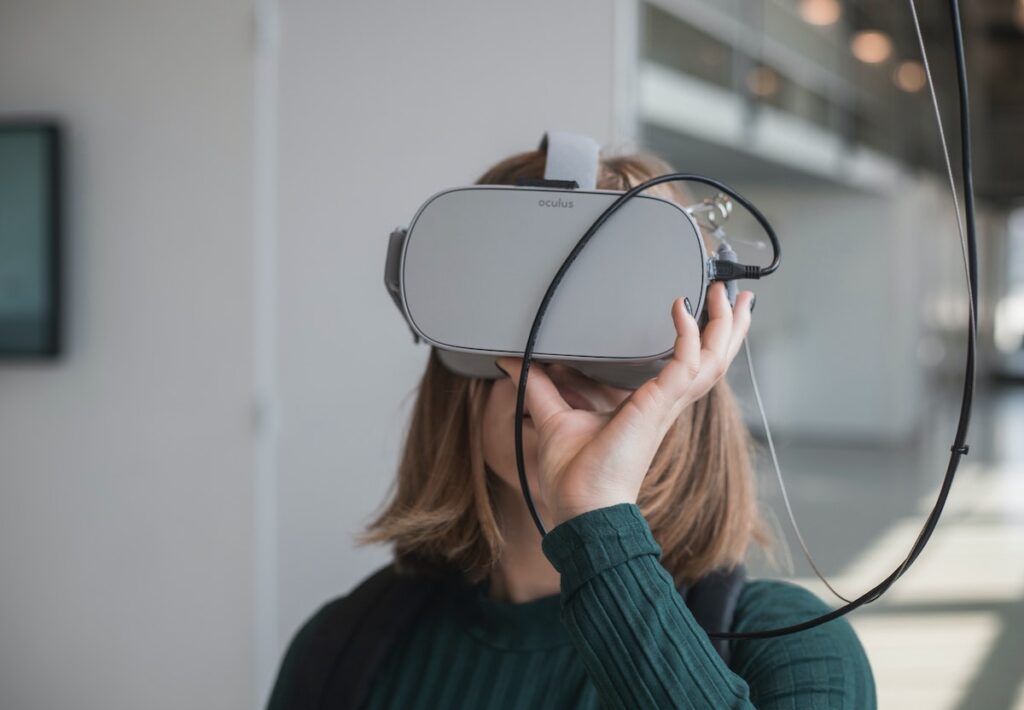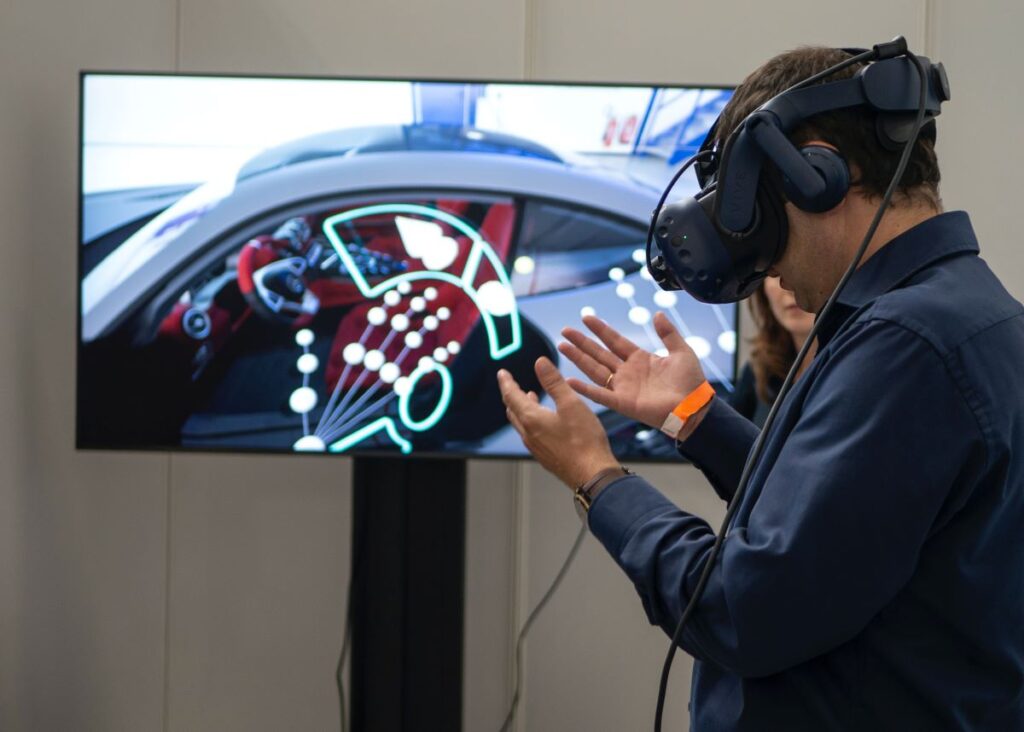
Most people associate Virtual Reality (VR) with video games and entertainment. But this new, upcoming technology has potential for much more than that. Amongst other things, VR is now used in clinical contexts. What defines VR is that it allows the user to move in a three-dimensional environment, typically using a headset and a hand-held controller. This means that it feels like playing a computer game, but instead of looking at a screen, the virtual environment is all around you and you can move freely inside of it, as if it was the real world. VR technology is not new, but it is becoming more and more popular and technically advanced, which makes it more affordable and easy to use.
People use VR in many different fields: industrial design, higher education, training, and also medical contexts, like rehabilitation after brain injury, Parkinson’s disease, disability management, and more. In psychology and psychiatry, it has successfully been used to treat post-traumatic stress disorder, anxiety, and phobias (Gregg & Tarrier, 2007; Krijn et al., 2004; Pull, 2005; Emmelkamp et al., 2002). However, as a possible tool to treat psychotic symptoms, VR is still quite new. Other reviews have been carried out on the use of VR to treat schizophrenia and other psychotic disorders, and have concluded that it is a promising tool. They suggested that VR can be useful for cognitive rehabilitation, social skills training, and also as a diagnostic tool to test which symptoms are present in a realistic environment (Park et al., 2019; Rus-Calafell et al., 2017; Valmaggia et al., 2016; Velig et al., 2014).
Immersive vs Interactive VR
There are two different things out there that are often called VR: “immersive” and “interactive” VR:
- Immersive VR is when people wear a device on their head that makes them feel like they are really inside the virtual environment.
- Interactive VR is when people sit in front of a screen on which they see a virtual environment, like in computer games.
It is important to keep this in mind and not to mix up the two types of approaches when it comes to reviewing them as possible treatment tools. Previous reviews have not always done this. The recently published review that we are summarising here focuses only on immersive VR treatment approaches, and examines their potential to treat schizophrenia (Bisso et al, 2020).
Read previous Mental Elf blogs about virtual reality and schizophrenia.

Virtual reality has many uses – this review explores whether virtual reality could help to treat schizophrenia.
Methods
The researchers collected studies on clinical applications of VR for the treatment of schizophrenia spectrum disorders, and summarised their findings in a review paper. They searched on the platforms Web of Science, EMBASE, PsycINFO and CINHAL using several different relevant search terms (for example “virtual reality” and “psychosis”). They included publications that were available on these platforms between April 2019 and June 2020. In order to be included, studies had to use immersive VR and report on whether the treatment had effects on social skills, cognition, delusions, paranoia and auditory verbal hallucinations (AVH).
The researchers were using a very systematic approach to collecting, reviewing and analysing the available data, following previously established guidelines (PRISMA guidelines 2009 for Systematic Reviews, Moher et al., 2009). This helps to make their work transparent and reliable.
Although the researchers originally collected 2601 studies, they ended up excluding so many studies from their review that they were left with only 6 studies. The large majority of studies collected turned out not to be relevant to the topic they had defined for their review. Other studies were on topic, but had to be excluded due to the inclusion criteria the researchers had defined. The sample sizes of the studies that remained were relatively small and the study design differed from case to case. This means that we cannot draw any strong conclusions from the available data at this stage, which the authors pointed out themselves.
Results
Two of the six studies reviewed explored the treatment of delusions and paranoia. The first of these two (Freeman et al., 2016) used VR to expose patients to the things they are afraid of, which is called “exposure therapy”. They compared two different groups in their study, one of which they treated with VR exposure therapy only, and the other they treated with VR exposure and elements of cognitive behaviour therapy (CBT). Both were effective, but VR-CBT was better. The second of the two studies (Pot-Kolder et al., 2018) only used VR-CBT in the first place and confirmed that it was an effective treatment strategy for paranoia. Both studies found that the effect was not just limited to the lab, but was carried over to daily life. Patients showed less safety behaviours and fewer social and cognitive problems.
One study focused on auditory verbal hallucinations (AVH) using avatars (Du Sert et al., 2018). Avatar therapy is a new approach, where patients suffering from hallucinations in which they are being persecuted, create avatars on a computer which represent their hallucinated persecutor, and then have conversations with those avatars. After immersive avatar therapy, patients suffered from less strong AVH, showed fewer symptoms of depression, and overall had a better quality of life. During the therapy, patients learned some new coping strategies for dealing with their hallucinations. When they were asked how they felt three months later, they reported that they had improved after the therapy had ended.
Two of the reviewed studies dealt with cognitive deficits (La Paglia et al., 2013, 2016). In those studies, which were performed by the same group of researchers, everyday life situations were recreated in VR, in order to give patients a chance to practice them. Patients moved in different realistic VR environments, like parks, supermarkets, or the beach. The researchers compared the progress of those patients with that of a control group, which received classic Integrated Psychological Therapy (which also targets cognitive and social skills, but not in a VR environment). They found that both treatment strategies had good effects, but using VR was overall more effective.
The last study that was included in the review focused on social skills (Park et al., 2011). It compared patients who were treated with social skill training in VR to traditional social skills training. In the virtual version, patients interacted with avatars, and in the traditional version, they interacted with actors and audio-video material. VR based treatment was better for conversational skills and seemed to make patients feel more confident and motivated. However, VR treatment was worse when it came to vocal and non-verbal skills.

The limited evidence that we have so far shows that virtual reality is a promising tool for treating psychosis and improving cognition, but that in some cases interaction with real humans could not be replaced.
Conclusions
Only very few studies have been carried out on this topic so far. Nevertheless, the few studies that exist seem promising: They were able to treat different symptoms of psychosis, like delusions, hallucinations, and also social skills and cognitive capacities. There is a small amount of evidence to suggest that the effects of the treatments seemed to persist long-term, but we need more reliable science to be sure of this. A great advantage of this kind of treatment is that it is non-invasive and so should have few side-effects, although again more research is needed to confirm this.

Virtual reality treatments are still too new to be well understood, but the possibilities seem promising.
Strengths and limitations
In the future we will need more studies on the use of VR for psychiatric treatments, and the review makes some suggestions for improving that research. It is important that we distinguish clearly between immersive and non-immersive types of VR. In the scientific literature, this distinction is not always made clear. The authors of the review suggest to stop using the term VR for non-immersive computer interactions, because this only confuses people. The interesting and promising aspect of VR for psychiatric treatments is the fact that it is immersive. Future studies should focus on creating interactive, immersive virtual environments that imitate social interactions in a realistic way and that make it possible to develop a complex virtual reality experience.
On the other hand, while the review points out the irregular use of the term “VR” to refer to both immersive VR and more “classical” video games, it does not contain much information about what additional benefits an immersive virtual environment could have over traditional computer-based interfaces. Since immersive VR is a relatively new technology, it seems likely that much more information would be available on the benefits of using non-immersive computer interactions for treating schizophrenia. The advantages that the researchers point out for VR therapy compared to conventional therapy (based on drugs or psychotherapy with human therapists) – such as standardisation, reproducibility, lack of side effects, adaptability to patients’ needs, no risk of pharmacological resistance – also seem to be true for using non-immersive computer games. What are the specific benefits of immersive over non-immersive computer-based therapy? Do we know? Maybe it’s premature to focus research exclusively on immersive VR, considering the small number of studies that are available so far.
Many of the findings that have been made so far are promising, but in order to be more confident, studies should be replicated with more patients, and the effects of virtual CBT should be compared directly to traditional CBT, because at this stage it is not clear whether there is any benefit to doing CBT virtually rather than with a normal therapist.
The review does not spend a lot of time discussing the advantages and disadvantages of VR treatments as opposed to cognitive therapy with a real human doctor. It’s clear that VR treatments are more promising than traditional computer games, but what makes VR better than a human therapist? The only argument that the review offers is that VR is easier to control and reproduce, which is a strong point. However, future studies should also compare VR treatment outcomes to classical psychotherapy results and be critical of possible disadvantages. The goal of VR research should be to complement existing treatments and maybe replace those that come with negative side-effects, but not to replace human therapists. How VR can be used as a powerful addition to psychotherapy should be a major focus of future research – not how in the future we can let a machine do something that now is being done by humans.

Suggestions for future research: Focus on immersive VR and think about how to complement classic psychotherapy, not how to replace it.
Implications for practice
The authors of the review conclude that immersive VR has advantages over conventional treatment methods. Firstly, if possible, it is preferable to using drugs, because the VR treatment has no side-effects, and it could be used to treat symptoms that cannot be treated successfully with drugs. Secondly, it can be tailored very well to the needs of individual patients.
An important question that medical professionals will have to ask themselves is whether VR could possibly be better at anything compared to treatments involving real human interaction. The researchers that wrote the review argue that even if VR might not outperform humans at tasks that humans are especially good at, like social interactions, it has many advantages over classical approaches. The possibility to standardise and reproduce is much greater in VR based approaches than in a traditional face-to-face interaction between therapists and patients. A virtual environment is much more controlled than a real environment, which makes it possible to design treatments in a more accurate way, and which make VR a great diagnostic tool. For example, it is easier to identify triggers that may negatively affect a patient when using VR. It’s also easier to record and study physiological data (like eye movements, heart rate, blood pressure, etc.) or brain data.
Some protocols have been published for how to integrate automated psychological VR therapy into medical practice. These protocols suggest replacing the therapist through an avatar coach in cognitive therapy (Freeman et al., 2019a, 2019b). Additionally, new intervention protocols related to social cognition and social functioning have been proposed (Nijman et al., 2019). The first steps are made; now it is necessary that the knowledge and necessary technology should be distributed widely across hospitals and other medical institutions and can be integrated step by step into existing therapeutic practice.

First protocols for how to use virtual reality for psychiatric therapy already exist, but they have not arrived in wide-spread medical practice yet.
Statement of interests
No conflict of interest.
Links
Primary paper
Bisso, E., Signorelli, M. S., Milazzo, M., Maglia, M., Polosa, R., Aguglia, E., & Caponnetto, P. (2020). Immersive Virtual Reality Applications in Schizophrenia Spectrum Therapy: A Systematic Review. International Journal of Environmental Research and Public Health, 17(17), 6111.
Other references
Du Sert, O.P.; Potvin, S.; Lipp, O.; Dellazizzo, L.; Laurelli, M.; Breton, R.; LaLonde, P.; Phraxayavong, K.; O’Connor, K.; Pelletier, J.-F.; et al. Virtual reality therapy for refractory auditory verbal hallucinations in schizophrenia: A pilot clinical trial. (2018). Schizophr. Res., 197, 176–181.
Emmelkamp, P.M.; Krijn, M.; Hulsbosch, A.; De Vries, S.; Schuemie, M.J.; Van Der Mast, C. Virtual reality treatment versus exposure in vivo: A comparative evaluation in acrophobia. (2002). Behav. Res. Ther., 40, 509–516.
Freeman, D.; Yu, L.-M.; Kabir, T.; Martin, J.; Craven, M.P.; Leal, J.; Lambe, S.; Brown, S.; Morrison, A.; Chapman, K.; et al. Automated virtual reality (VR) cognitive therapy for patients with psychosis: Study protocol for a single-blind parallel group randomised controlled trial (gameChange). (2019a). BMJ Open, 9, e031606.
Freeman, D.; Lister, R.; Waite, F.; Yu, L.-M.; Slater, M.; Dunn, G.; Clark, D.M. Automated psychological therapy using virtual reality (VR) for patients with persecutory delusions: Study protocol for a single-blind parallel-group randomised controlled trial (THRIVE). (2019b). Trials, 20, 87.
Gregg, L.; Tarrier, N. Virtual reality in mental health. (2007). Soc. Psychiatry Psychiatr. Epidemiol., 42, 343–354.
Krijn, M.; Emmelkamp, P.M.; Ólafsson, R.P.; Biemond, R. Virtual reality exposure therapy of anxiety disorders: A review. (2004). Clin. Psychol. Rev., 24, 259–281.
La Paglia, F.; La Cascia, C.; Rizzo, R.; Sideli, L.; Francomano, A.; La Barbera, D. Cognitive rehabilitation of schizophrenia through NeuroVr training. (2013). Stud. Health Technol. Inform., 191, 158–162.
La Paglia, F.; La Cascia, C.; Rizzo, R.; Sanna, M.; Cangialosi, F.; Sideli, L.; Francomano, A.; Riva, G.; La Barbera, D. Virtual reality environments to rehabilitation attention deficits in schizophrenic patients. (2016). Annu. Rev. CyberTherapy Telemed., 14, 143–148.
Moher, D.; Liberati, A.; Tetzlaff, J.; Altman, D. G.; & Prisma Group. Preferred reporting items for systematic reviews and meta-analyses: the PRISMA statement. (2009). PLoS medicine, 6(7), e1000097.
Nijman, S.A.; Veling, W.; Greaves-Lord, K.; Vermeer, R.R.; Vos, M.; Zandee, C.E.R.; Zandstra, D.C.; Geraets, C.N.W.; Pijnenborg, G.H.M. Dynamic Interactive Social Cognition Training in Virtual Reality (DiSCoVR) for social cognition and social functioning in people with a psychotic disorder: Study protocol for a multicenter randomized controlled trial. (2019). BMC Psychiatry, 19, 1–11.
Park, M.J.; Kim, D.J.; Lee, U.; Na, E.J.; Jeon, H.J. A literature overview of virtual reality (vr) in treatment of psychiatric disorders: Recent advances and limitations. (2019). Front. Psychol., 10, 505.
Pull, C.B. Current status of virtual reality exposure therapy in anxiety disorders: Editorial review. (2005). Curr. Opin. Psychiatry, 18, 7–14.
Rus-Calafell, M.; Garety, P.; Sason, E.; Craig, T.J.K.; Valmaggia, L. Virtual reality in the assessment and treatment of psychosis: A systematic review of its utility, acceptability and effectiveness. (2017). Psychol. Med., 48, 362–391.
Valmaggia, L.; Latif, L.; Kempton, M.J.; Rus-Calafell, M.; Kemptom, M.J.; Maria, R.-C. Virtual reality in the psychological treatment for mental health problems: An systematic review of recent evidence. (2016). Psychiatry Res. Neuroimaging, 236, 189–195.
Veling, W.; Moritz, S.; Van Der Gaag, M. Brave new worlds—Review and update on virtual reality assessment and treatment in psychosis. (2014). Schizophr. Bull., 40, 1194–1197.
Photo credits
- Photo by Hammer & Tusk on Unsplash
- Photo by Maxim Hopman on Unsplash
- Photo by Priscilla Du Preez on Unsplash
- Photo by Ramón Salinero on Unsplash
- Photo by XR Expo on Unsplash
- Photo by Syd Wachs on Unsplash
